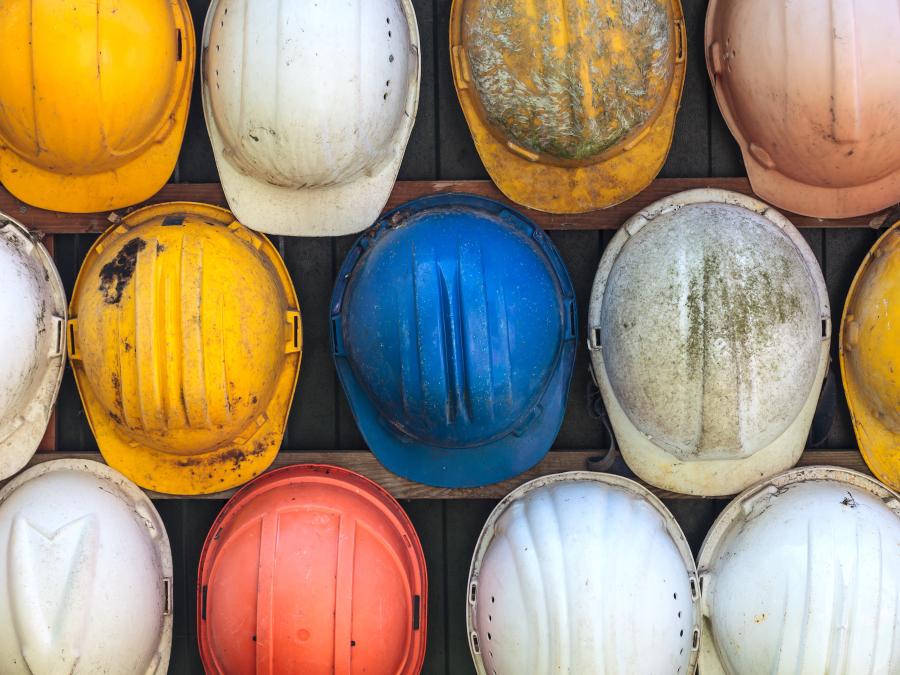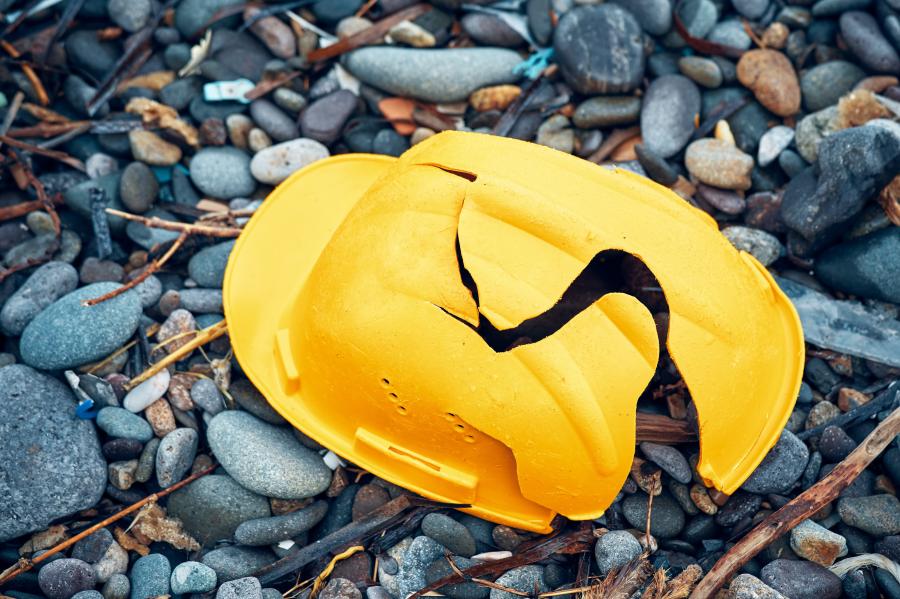Hard hats prevent injury, but not all OSHA-approved hard hats are the same, and none of them lasts forever.
Two major construction feats, the Hoover Dam and the Golden Gate Bridge, marked the first times an employer mandated the use of hard hats on the job. The iconic head protection has come a long way since, and in 2017 a contractor first required helmets over hard hats because of the high rate of brain injuries and falls in the construction industry.
Worn to prevent head injury from falling objects, debris or weather-related elements, hard hats are often taken for granted.
It's not uncommon for workers to bump into fixed objects on a site or to encounter electrical hazards, said Houston safety consulting company Safety by Design Inc.
Hard hats prevent injury. But not all OSHA-approved hard hats or safety helmets are the same, and none of them lasts forever.
Once you've chosen the right helmet for the job, it must be fitted properly, inspected regularly and replaced when it becomes damaged, according to OSHA.
A hard hat must resist penetration by falling or stationary objects, absorb shock from a blow to the head and be water-resistant and slow to burn.
When hard-hat safety is not required on a job site, a bump cap may be worn to prevent minor bumps that can lead to bruises, cuts or abrasions, according to Safety by Design.
However, bump caps are not approved by OSHA or ANSI because they do not protect against falling objects.
And they are never appropriate for workplaces that require hard hat protection.
Hard hats must fit properly to do their job of protecting the head. The suspension, the adjustable head harness, keeps the helmet shell in place.
"A firm and snug fit ensures the helmet stays in place when confronted with various work conditions," said Jill Novak, e-commerce specialist of Orr Safety, Louisville, Ky.
Meeting Safety Standards
The inside of a hard hat that meets requirements should clearly display the manufacturer's name; ANSI standard, type and class; size; and date of manufacture.
According to Safety by Design, certain types and classes of helmet will display guiding arrows, an "LT" (low temperature) mark, and an "HV" (high visibility) description.
The safety consulting company noted that OSHA-compliant hard hats are required in the following situations:
- if objects may fall from overhead and potentially strike employees;
- if there are stationary fixtures, such as beams and pipes, on which employees may bump their heads; or
- if electrical hazards exist and accidental head contact is a risk;
A hard hat meets OSHA's requirements when:
- It is the proper type and class (ANSI) for specific hazardous conditions;
- Its design performs against impact, penetration, and electrical shock; and
- It has undergone testing requirements to ensure its compliance.
"Beyond manufacturers' routine testing, employers should also verify that hard hats are fully compliant," noted Safety by Design.
ANSI logs two types of hard hats and three classes based on the varying levels of electrical hazard. Safety helmets must meet one of the two types.
Type I provides protection to the top of the head, while Type II protects both the top and the sides of the head.
Class G covers general hard hats rated for 2,200 volts. Class E are electrical hard hats rated for 20,000 volts, and Class C includes conductive hard hats that do not offer electrical protection at all.
Over the past few years the climbing, biking style helmet with chinstraps, considered a game-changer in helmet design, have increased in popularity on the construction site.
And, ohsonline.com reports that a number of large companies have added helmets designed with chinstraps to provide more lateral protection to their head protection offerings.
This new type of head protection won't fall off if a worker trips or falls, according to Samantha Heim, writing for the occupational health and safety website. Two popular helmets are the cap style and full brim style.
Heim noted that "some hard hats can accommodate accessories as well, such as shields and visors, headlamp mounts, ear protection, neck protectors and more."
There are also various options in the design of the suspension. Today, four-, six- or eight-point suspensions are available.
"Similarly, there are three adjustable forms: the ratchet, pin lock and one-touch," wrote Heim.
"Often, a variety of colors and high-visibility options are offered for more personalization."
When to Hang Up Your Hat
OSHA advises replacing a hard hat that shows cracks, dents, penetration or wear from rough care and treatment.
The agency has not set a hard hat expiration date, but most manufacturers replace hard hats every five years. They replace the support strap annually.
Safety by Design reminds that every time hard hats are used, they must then be inspected for any damage that may render them ineffective and non-compliant.
"Beyond a visual inspection, hard hats should be squeezed with two hands, applying force," stressed the safety consultant. "If squeaking or unusual sounds are detected, it is time for a replacement."
Helmet shells are designed to be shock absorbent, yet the material properties used to protect workers also can be sensitive to chemical attack, according to agg-net.com.
"More than half of workers mark or apply decals and labels to their helmet, unknowingly decreasing its durability by compromising the integrity of the material it is made from," noted the UK aggregates industry website.
"To maintain safety standards, workers should remove any unchecked stickers and sanitize and clean their head protection equipment in a safe environment."
The site noted that excessive wear and tear in extreme environments, such as exposure to high temperatures, chemicals or sunlight, can significantly shorten the product's life span.
"When evaluating a time frame for safe usage, workers should conduct risk assessments to consider their own unique environment," suggested the website. "Workers should also consider the daily hazards they face in the workplace."
The European Standard for industrial safety helmets, EN 397, which provides shock absorption, penetration resistance and protection against impact. The standard applies to workers on the ground.
Maintaining Your Hard Hat
Novak of Orr Safety stressed that before and after each use, every hard hat should be inspected. She suggested a general inspection process:
1. Look at the shell of the hat for any breakage, cracks, craze patterns, discoloring, chalky appearance or anything that appears out of the norm.
2. Inspect the suspension for loss of flexibility, cracks, breaks, frays or damaged stitching.
3. Ask the worker wearing the hat if any impact or penetration occurred during their time using it.
4. If any of these conditions exist, replace the suspension or shell immediately (MSA 2010).
"Regularly scheduled maintenance sessions with your helmet make all the difference," suggested Novak. She lists the following steps to make sure your helmet is well cared for:
- Clean your helmet as often as you inspect it. Avoid harsh detergent; use mild soap and warm water when cleaning it.
- Avoid dropping, throwing, or using your helmet to sit on or as support. She noted that "safety-rated hard hats are not to be used as a vehicular or sports helmet."
- Never store personal belongings, such as cigarettes or earplugs, in between the suspension or shell of a hard hat. "These objects can transmit a large force to the head and neck, causing serious injury or death."
- Completely avoid using paints, solvents or hydrocarbon-type cleaners. "These substances can cause unnoticeable damage," said Novak.
- At the end of your day, store your helmet in a clean, dry area that does not exceed 120F.
- Establish and maintain a replacement program for your hard hats, and all your PPE. Keep detailed purchase records and damage reports to keep track equipment lifecycles. CEG
Lucy Perry
Lucy Perry has 30 years of experience covering the U.S. construction industry. She has served as Editor of paving and lifting magazines, and has created content for many national and international construction trade publications. A native of Baton Rouge, Louisiana, she has a Journalism degree from Louisiana State University, and is an avid fan of all LSU sports. She resides in Kansas City, Missouri, with her husband, who has turned her into a major fan of the NFL Kansas City Chiefs. When she's not chasing after Lucy, their dachshund, Lucy likes to create mixed-media art.
Read more from Lucy Perry here.
Today's top stories
















